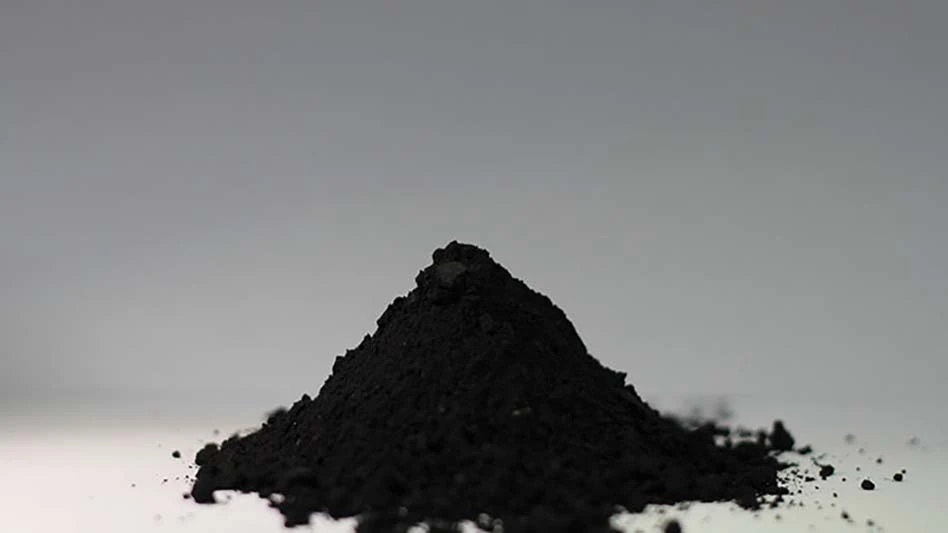
Centrifugal dryer features three-door housing
eXso: This centrifugal dryer from Maag is designed for drying resin pellets produced by underwater and wet-cut strand pelletizers. It is especially appropriate for compounders and recyclers that require a drying step prior to packaging pellets. The eXso provides throughputs of more than 18,000 pounds per hour.
What’s new? The dryer and features such as its three-door housing. Based on customer feedback, the new design improves upon all aspects of the company’s legacy dryers.
Benefits: Faster drying and improved performance. The new housing improves the operator’s view and access to the interior, which permits faster and more effective cleaning, reducing the risk of cross-contamination for improved product quality. The reliable, compact unit reduces product changeover times.
Maag Gala Inc., Eagle Rock, Virginia, 540-884-2589

Black masterbatch enhances recyclability of food packaging
AF-Carbon PE 950811 IR black: AF-Color’s newest black masterbatch for plastics can be detected by recycling systems that use infrared (IR) light to identify different materials. It is an alternative to commonly used carbon black pigments that absorb IR light, making it difficult for recycling facilities to identify plastic products that contain them. The masterbatch is for use with polyethylene and polypropylene resins and, in some cases, is appropriate for polyamide 6 and acrylonitrile butadiene styrene resins.
What’s new? The AF-Carbon PE 950811 IR black grade, which is targeted for use in food packaging.
Benefits: Deep black color and recyclability. The alternative to carbon black can enhance the recyclability and circularity of a wide variety of plastic packaging.
AF-Color, Branch of Akro-Plastic GmbH, Niederzissen, Germany, 49-2636-8092-0, www.af-color.com

NE J deduster employs high-efficiency IE5 motors
NE J deduster: Nestro manufactures air filtration, air purifier and deduster units for a wide range of industries, including plastics and plastics recycling facilities. Its NE line of dedusters is designed for small to midsized businesses. The high-efficiency dedusters are configured with the fan located after the vacuum filter unit, so the fan doesn’t come into contact with the material being filtered.
What’s new? The NE J line of mobile dedusters, which has an updated, modular design that employs high-efficiency IE5 motors. The frequency-controlled motors run at the optimal operating point and are quieter than their predecessors. An automatic fire-extinguishing system that hermetically seals the unit to suffocate fire also is new. The NE J line is scheduled to be available in the first quarter of the year.
Benefits: Low operating costs. Energy costs can be 22 percent lower than for earlier units operating with IE3 motors. The NE J line is available in four models, with air flows of up to 335,489 cubic feet per hour. Disposal options include dust bins, separator locks and a briquette press. Each unit has a wired touch-panel terminal that gives the operator more freedom of movement around the deduster. The NE J units can be delivered in segments to pass through narrow spaces and can then be assembled on-site.
Nestro Lufttechnik GmbH, Schkölen, Germany, 49-36694-41-0, www.nestro.com

Belt melt filter cleans highly contaminated postconsumer PET
ABMF PET-C Continuous: BritAS GmbH has designed this belt melt filter specifically for cleaning heavily contaminated postconsumer polyethylene terephthalate (PET). It also can be used to process low-viscosity plastics that are similar to PET, such as polyamide. It is appropriate for use with underwater and strand pelletizers. Its screen belts have a Dutch weave mesh and provide filtration as fine as 20 microns. During each filter change, a clean screen mesh is inserted automatically without stopping production. Up to three screen belts can be inserted at the same time, allowing for precise adjustment of the fineness of the filter.
What’s new? The ABMF PET-C Continuous, the latest model in the company’s ABMF line of automatic belt melt filters. Its new dual-cavity technology ensures a continuous flow of melt and its redesigned heating system helps reduce operating costs. The system comes in four sizes, with filter surface areas ranging from 1.2 square feet to 3.4 square feet and maximum outputs ranging from 3,770 pounds per hour to 10,580 pounds per hour.
Benefits: High-quality recycled pellets and low operating costs. The fully automatic filter efficiently removes contaminants with melt loss of less than 1 percent.
BritAS Filtration Systems, Tucker, Georgia, 678-325-6708, www.britas.de/en

Screw pump boosts performance of extrusion lines
SPA screw pump: Fimic’s SPA screw pump is designed to boost performance of extrusion lines recycling plastics, including those processing challenging postconsumer resins (PCR). For compounding postindustrial materials, it can accept melt from a twin-screw extruder and boost the melt pressure as it flows into the filter, improving the filter’s output and avoiding backflow. For PCR applications requiring double filtration, a single-screw extruder feeds melt directly into a filter, then the SPA can be placed between the first filter and the second filter. In that arrangement, the SPA decreases the outlet pressure of the first filter, boosting its productivity, then rebuilds pressure as the melt enters the second filter. Fimic says the SPA, or “Screw Pump Antonio,” is named after Fimic employee Antonio Canaia, who created the company’s first automatic self-cleaning melt filter more than 20 years ago.
What’s new? The SPA, which is an alternative to traditional gear pumps.
Benefits: Robust construction and lower operating costs. Gear pumps often need a filter to protect them from contaminants in recycled melt and require regular maintenance and periodic downtime to conduct expensive gear replacements. The SPA screw pump’s design makes it less prone to damage and provides longer wear-part life than an equivalent gear pump.
Sponsored Content
SENNEBOGEN 340G telehandler improves the view in Macon County, NC
An elevated cab is one of several features improving operational efficiency at the Macon County Solid Waste Management agency in North Carolina. When it comes to waste management, efficiency, safety and reliability are priorities driving decisions from day one, according to staff members of the Macon County Solid Waste Management Department in western North Carolina. The agency operates a recycling plant in a facility originally designed to bale incoming materials. More recently, the building has undergone significant transformations centered around one machine: a SENNEBOGEN telehandler (telescopic handler).
Sponsored Content
SENNEBOGEN 340G telehandler improves the view in Macon County, NC
An elevated cab is one of several features improving operational efficiency at the Macon County Solid Waste Management agency in North Carolina. When it comes to waste management, efficiency, safety and reliability are priorities driving decisions from day one, according to staff members of the Macon County Solid Waste Management Department in western North Carolina. The agency operates a recycling plant in a facility originally designed to bale incoming materials. More recently, the building has undergone significant transformations centered around one machine: a SENNEBOGEN telehandler (telescopic handler).
Sponsored Content
SENNEBOGEN 340G telehandler improves the view in Macon County, NC
An elevated cab is one of several features improving operational efficiency at the Macon County Solid Waste Management agency in North Carolina. When it comes to waste management, efficiency, safety and reliability are priorities driving decisions from day one, according to staff members of the Macon County Solid Waste Management Department in western North Carolina. The agency operates a recycling plant in a facility originally designed to bale incoming materials. More recently, the building has undergone significant transformations centered around one machine: a SENNEBOGEN telehandler (telescopic handler).
Sponsored Content
SENNEBOGEN 340G telehandler improves the view in Macon County, NC
An elevated cab is one of several features improving operational efficiency at the Macon County Solid Waste Management agency in North Carolina. When it comes to waste management, efficiency, safety and reliability are priorities driving decisions from day one, according to staff members of the Macon County Solid Waste Management Department in western North Carolina. The agency operates a recycling plant in a facility originally designed to bale incoming materials. More recently, the building has undergone significant transformations centered around one machine: a SENNEBOGEN telehandler (telescopic handler).
Sponsored Content
SENNEBOGEN 340G telehandler improves the view in Macon County, NC
An elevated cab is one of several features improving operational efficiency at the Macon County Solid Waste Management agency in North Carolina. When it comes to waste management, efficiency, safety and reliability are priorities driving decisions from day one, according to staff members of the Macon County Solid Waste Management Department in western North Carolina. The agency operates a recycling plant in a facility originally designed to bale incoming materials. More recently, the building has undergone significant transformations centered around one machine: a SENNEBOGEN telehandler (telescopic handler).
Sponsored Content
SENNEBOGEN 340G telehandler improves the view in Macon County, NC
An elevated cab is one of several features improving operational efficiency at the Macon County Solid Waste Management agency in North Carolina. When it comes to waste management, efficiency, safety and reliability are priorities driving decisions from day one, according to staff members of the Macon County Solid Waste Management Department in western North Carolina. The agency operates a recycling plant in a facility originally designed to bale incoming materials. More recently, the building has undergone significant transformations centered around one machine: a SENNEBOGEN telehandler (telescopic handler).
Fimic Srl, Carmignano di Brenta, Italy, 39-049-595-71-63, www.fimic.it

Lump breaker features durable design and compact footprint
Nibbler:This lump breaker from Gericke USA employs a low-speed, high-torque rotating paddle assembly to efficiently and reliably reduce materials to particles as small as 1 millimeter. The Nibbler can break down agglomerates that have formed in dry material, such as powders or other additives for plastic recycling held in storage or in bulk bags and containers. It also can reduce plastic scrap and off-spec products to particle sizes suitable for reprocessing.
What’s new? The GNB version of the Nibbler, which makes it easy for operators to quickly adjust the space between the cutting screen and paddles by as much as 9 millimeters without tools.
Benefits: Fast cleaning. The breaker’s housing and machinery have been designed for durability while maintaining a compact footprint. The GNB comes in stainless steel as standard and is available in high-temperature, process safety and ATEX-compliant models. Gericke’s RotaSafe system, which automatically shuts down power to the drive motor when metal-to-metal contact is detected, is available as an option.
Gericke USA Inc., Somerset, New Jersey, 855-888-0088, www.gerickegroup.com
Get curated news on YOUR industry.
Enter your email to receive our newsletters.

Explore the Spring 2022 Plastics Recycling Issue
Check out more from this issue and find your next story to read.
Latest from Recycling Today
- Sims is part of Australian recycling loop
- Tariffs target steel exporters Brazil, Canada and South Korea
- Buy Scrap Software to showcase its software at Scrap Expo in September
- LG details recycling activities
- Algoma EAF is up and running
- Toyota-Tsusho completes acquisition of Radius Recycling
- CATL, Ellen MacArthur Foundation aim to accelerate circular battery economy
- Commentary: Expanded polystyrene is 98 percent air, 2 percent plastic and 100 percent misunderstood






